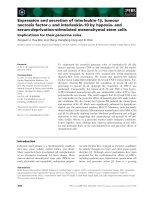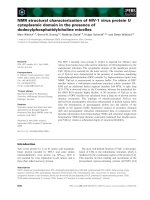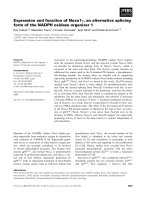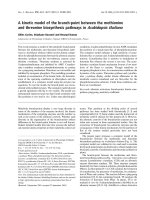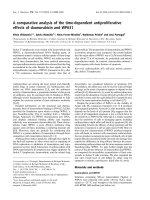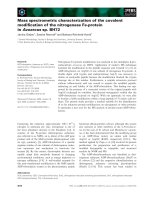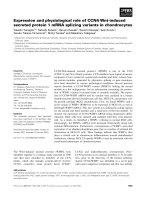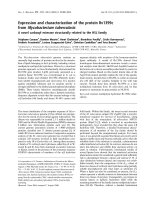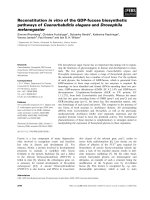Báo cáo khoa học: Expression and characterization of the biofilm-related and carnosine-hydrolyzing aminoacylhistidine dipeptidase from Vibrio alginolyticus pot
Bạn đang xem bản rút gọn của tài liệu. Xem và tải ngay bản đầy đủ của tài liệu tại đây (1.39 MB, 14 trang )
Expression and characterization of the biofilm-related and
carnosine-hydrolyzing aminoacylhistidine dipeptidase from
Vibrio alginolyticus
Ting-Yi Wang*, Yi-Chin Chen*, Liang-Wei Kao, Chin-Yuan Chang, Yu-Kuo Wang, Yen-Hsi Liu,
Jen-Min Feng and Tung-Kung Wu
Department of Biological Science and Technology, National Chiao Tung University, Hsin-Chu, Taiwan, China
Vibrio alginolyticus is one of twelve recognized marine
Vibrio species that have been identified as pathogenic
for humans and marine animals. This species causes
infection in shrimps, fish, shellfish and squids, as well
as in humans who are infected via consumption of
undercooked seafood or exposure of wounds to warm
seawater in coastal areas [1–3]. V. alginolyticus infects
grouper culture by forming a biofilm in the intestine
and causes fish mortality due to gastroenteritis syn-
drome [4]. A disease outbreak of shrimp farming in
1996 was also attributed to V. alginolyticus virulence
[5]. In infected humans, clinical symptoms include gas-
troenteritis, wound infections and septicemia [6–8] and,
more rarely, ear infections, chronic diarrhea exclusively
in AIDS patients, conjunctivitis and post-traumatic
intracranial infection [9–11]. Thus, prevention, early
Keywords
aminoacylhistidine dipeptidase; biofilm;
carnosinase; metallopeptidase H clan;
Vibrio alginolyticus
Correspondence
T K. Wu, Department of Biological Science
and Technology, National Chiao Tung
University, Hsin-Chu, Taiwan, China
Fax: +886 3 5725700
Tel: +886 3 5729287
E-mail:
*These authors contributed equally to this
work
(Received 1 May 2008, revised 5 August
2008, accepted 11 August 2008)
doi:10.1111/j.1742-4658.2008.06635.x
The biofilm-related and carnosine-hydrolyzing aminoacylhistidine dipepti-
dase (pepD) gene from Vibrio alginolyticus was cloned and sequenced. The
recombinant PepD protein was produced and biochemically characterized
and the putative active-site residues responsible for metal binding and
catalysis were identified. The recombinant enzyme, which was identified as
a homodimeric dipeptidase in solution, exhibited broad substrate specificity
for Xaa-His and His-Xaa dipeptides, with the highest activity for the His-
His dipeptide. Sequence and structural homologies suggest that the enzyme
is a member of the metal-dependent metallopeptidase family. Indeed, the
purified enzyme contains two zinc ions per monomer. Reconstitution of
HisÆTag-cleaved native apo-PepD with various metal ions indicated that
enzymatic activity could be optimally restored when Zn
2+
was replaced
with other divalent metal ions, including Mn
2+
,Co
2+
,Ni
2+
,Cu
2+
and
Cd
2+
, and partially restored when Zn
2+
was replaced with Mg
2+
. Struc-
tural homology modeling of PepD also revealed a ‘catalytic domain’ and a
‘lid domain’ similar to those of the Lactobacillus delbrueckii PepV protein.
Mutational analysis of the putative active-site residues supported the
involvement of His80, Asp119, Glu150, Asp173 and His461 in metal bind-
ing and Asp82 and Glu149 in catalysis. In addition, individual substitution
of Glu149 and Glu150 with aspartic acid resulted in the partial retention of
enzymatic activity, indicating a functional role for these residues on the
catalysis and zinc ions, respectively. These effects may be necessary either
for the activation of the catalytic water molecule or for the stabilization of
the substrate–enzyme tetrahedral intermediate. Taken together, these results
may facilitate the design of PepD inhibitors for application in antimicrobial
treatment and antibody-directed enzyme prodrug therapy.
Abbreviations
CPG2, Pseudomonas sp. carboxypeptidase G2; hAcy1, human aminoacylase-1; MH, metallopeptidase H clan; OPA, O-phthaldialdehyde;
PepD, aminoacylhistidine dipeptidase.
FEBS Journal 275 (2008) 5007–5020 ª 2008 The Authors Journal compilation ª 2008 FEBS 5007
detection and treatment of V. alginolyticus infections
are important to maintain human and marine animal
safety.
Dipeptidases play a general role in the final break-
down of peptide fragments produced by other peptid-
ases during the protein degradation process [12].
Aminoacylhistidine dipeptidase (EC 3.4.13.3; also Xaa-
His dipeptidase, carnosinase and PepD) catalyzes the
cleavage and release of an N-terminal amino acid,
which is usually a neutral or hydrophobic residue,
from a Xaa-His dipeptide or degraded peptide frag-
ment [13]. The PepD enzyme occurs extensively among
prokaryotes and eukaryotes and belongs to the metal-
lopeptidase family M20 from the metallopeptidase H
(MH) clan (MEROPS: the Peptidase Database; http://
merops.sanger.ac.uk/) [14,15]. This enzyme was gener-
ally identified as a dipeptidase with broad substrate
specificity. Other proteins have been reported to have
dipeptidase activity on unusual dipeptide carnosine
(b-Ala-l-His) and homocarnosine (c-amino-butyl-His)
as well as on a few distinct tripeptides [13,16,17]. Other
functional enzymes from the M20 family include ami-
noacylase-1 [18], Pseudomonas sp. carboxypeptidase
G2 (CPG2) [19–21], Saccharomyces cerevisiae carboxy-
peptidase Y [19], bacterial PepT and PepV [15,20,21],
Escherichia coli PepD [22], human nonspecific dipepti-
dase and human brain-specific carnosinase [16]. These
enzymes have been implicated in cleavage of the final
peptide fragments for amino acid utilization [13].
These enzymes have shown potential for application as
an anti-bacterial target or a therapeutic agent for can-
cer treatment [21] and may possibly play roles in aging
as well as neurodegenerative or psychiatric diseases
[16].
Biofilm formation has been found in a wide variety
of microbial infections within the body or on the sur-
face of the host. Bacterial adhesion and subsequent
biofilm formation stimulate the expression of biofilm-
specific genes [23,24]. Alternatively, expression of pepD
may negatively affect biofilm formation in E. coli [25].
V. alginolyticus may form a biofilm in the intestines of
infected fish [4]. Although several members of M20
family enzymes have been studied extensively, the
functional residues of PepD-related enzymes are poorly
understood. To determine the importance of PepD in
affecting biofilm formation and serving as a potential
target for antimicrobial agents, we examined the
V. alginolyticus PepD protein. In the present study, we
present the cloning and expression of the V. alginolyti-
cus pepD gene, the purification and biochemical char-
acterization of the produced PepD recombinant
protein, as well as a detailed analysis of its substrate
specificity and the effects of metals on enzymatic activ-
ity and kinetic parameters. We also identified the puta-
tive amino acid residues responsible for catalysis and
metal binding based on multiple sequence alignment
and homology modeling from the related M20 family
enzymes.
Results and Discussion
Cloning, sequence analysis and identification of
the V. alginolyticus pepD gene
To clone the pepD gene from V. alginolyticus, we first
aligned and analyzed multiple nucleic acid sequences
of putative pepD genes from various Vibrio species to
find highly conserved sequences. A DNA fragment of
approximately 1.5 kb was amplified by PCR using
V. alginolyticus ATCC 17749 genomic DNA as a
template. Following confirmation of both the N- and
C-terminus sequence of the pepD gene, an ORF that
contained 1473 nucleotides and coded for a polypep-
tide of 490 amino acids was identified (Fig. 1).
Sequence analysis predicted a protein with a molecular
mass of 53.6 kDa and an isoelectric point of pH 4.7.
Production of the V. alginolyticus PepD protein
The V. alginolyticus pepD gene was then subcloned
into the expression plasmid pET28a(+) and subse-
quently transformed into E. coli BL21(DE3)(pLysS)
cells to generate the pET28a(+)-pepD recombinant
plasmid for protein over-expression. Following isopro-
pyl thio-b-d-galactoside induction for 6 h at 37 °C, the
produced protein was harvested for protein purifica-
tion using a Ni SepharoseÔ 6 Fast Flow column and
eluted with imidazole. SDS ⁄ PAGE of the homoge-
neous protein revealed a molecular mass of approxi-
mately 54 kDa (Fig. 2, lane 3) in agreement with the
predicted molecular mass of 53.6 kDa. Immunoblot
analysis with PepD monoclonal antibody also
produced a single band (Fig. 2, lane 4). By contrast,
the molecular mass of native PepD was 100.7 ±
6.0 kDa as determined by analytical sedimentation
velocity ultracentrifugation (Fig. 3A), whereas this
technique revealed a molecular mass of 51 kDa for
the denatured PepD (Fig. 3B). These results indicate
that the PepD protein associates as a homodimer in
solution.
Biochemical characterization of V. alginolyticus
PepD
The pH and temperature optima for purified recom-
binant PepD carnosine hydrolysis, substrate specific-
Characterization of V. alginolyticus PepD T Y. Wang et al.
5008 FEBS Journal 275 (2008) 5007–5020 ª 2008 The Authors Journal compilation ª 2008 FEBS
Fig. 1. Nucleotide and predicted amino acid sequences of the V. alginolyticus pepD gene. His80, Asp119, Glu150, Asp173 and His461 (yel-
low) are putative metal ion-binding residues. Asp82, Glu149 and His219 (aquamarine) are putative catalytic residues. The Ile318–Ser397 resi-
dues (brown) encompass the expected dimerization domain.
T Y. Wang et al. Characterization of V. alginolyticus PepD
FEBS Journal 275 (2008) 5007–5020 ª 2008 The Authors Journal compilation ª 2008 FEBS 5009
ity, kinetic parameters, inhibition by a selection of
protease inhibitors and the effects of metal ions were
determined. The PepD activity was tested at various
pH values using citric acid (pH 4, 5 and 6) and
Tris–HCl (pH 6, 7, 7.4, 8.5, 9 and 9.5) (Fig. 4A).
The pH activity of PepD showed an optimal activity
in the range pH 7–7.4 and declined at more acidic
and alkaline pH values. PepD retained only 80%
and 86% of its maximal activity at pH 6 and 8.5,
respectively. The PepD activity temperature curve
was rather broad, with a range between 25–50 °C
and maximum activity at 37 °C (Fig. 4B). Thus,
PepD activity assays were performed at pH 7.4 and
37 °C.
The PepD from E. coli has been identified as a
dipeptidase with broad substrate specificity [22]. The
substrate specificity of V. alginolyticus PepD was
determined with seventeen peptides, including eleven
Xaa-His dipeptides, four His-Xaa dipeptides and two
His-containing tripeptides at pH 7.4 and 37 °C
(Fig. 5). The enzymatic activity on l-carnosine (b-Ala-
l-His) was defined as 100%. The enzymatic activity
was superior to that on l-carnosine for several Xaa-
His dipeptides, including a-Ala-His, Val-His, Leu-His,
Ile-His, Tyr-His, Ser-His and His-His, and two His-
Xaa dipeptides, namely His-Asp and His-Arg. Interest-
ingly, PepD exhibited its highest activity with the
His-His dipeptide, and this activity was approximately
two-fold higher than that with l-carnosine. Similarly,
a preference for a-Ala-His compared to l-carnosine
was first identified for bacterial PepD, although the
same result has been observed in human cytosolic non-
specific dipeptidase CN2 [16]. The enzyme exhibited
decreased activity toward Gly-His (70%). PepD did
not degrade b-Asp-l-His dipeptide, His-Ile dipeptide,
His-Val dipeptide or the Gly-His-Gly and Gly-Gly-His
tripeptides. These results indicate that the V. alginolyti-
cus PepD is a Xaa-His dipeptidase with broad sub-
strate specificities and that the enzymatic activity of
PepD on Xaa-His dipeptide is dependent on the charge
Fig. 2. SDS ⁄ PAGE and western blot analysis of purified V. algino-
lyticus PepD protein. Lane M, marker proteins: phosphorylase b
(97 kDa), bovine serum albumin (67 kDa), ovalbumin (45 kDa) and
carbonic anhydrase (30 kDa); lane 1, crude cell extracts of E. coli
BL21(DE3)pLysS carrying pET-28a(+) plasmid; lane 2, crude cell
extracts of E. coli BL21(DE3)pLysS carrying pET-28a(+)-pepD plas-
mid; lane 3, purified PepD from Ni-nitrilotriacetic acid column;
lane 4, western blot analysis of purified PepD with monoclonal anti-
PepD serum.
2.5
3.0
1.0
1.5
2.0
0.0
0.5
c (uM) distribution (fringes·kDa
–1
)
1.0
1.5
2.0
A
B
0.0
0.5
c (uM) distribution (fringes·kDa
–1
)
0 20406080100120
Molar mass (kDa)
0 20406080100120
Molar mass (kDa)
Fig. 3. Analytical ultracentrifugation of PepD protein. (A) The
calculated molecular mass of native PepD from sedimentation
coefficient (s) is approximately 100 664.94 ± 295 gÆmol
)1
. (B) The
calculated molecular mass of urea denatured PepD protein from
sedimentation coefficient (s) is approximately 51 091.49 ±
113 gÆmol
)1
.
Characterization of V. alginolyticus PepD T Y. Wang et al.
5010 FEBS Journal 275 (2008) 5007–5020 ª 2008 The Authors Journal compilation ª 2008 FEBS
of the N-terminus amino acid side chain because an
amino group in the a or b position of the N-terminus
residue did not affect the recognition and hydrolysis of
the dipeptide. In addition, PepD is similar to the
human nonspecific carnosinase CN2, which cannot
hydrolyze the brain-specific dipeptide GABA-His
(homocarnosine), and is different from PepV due to
its inability to degrade unusual tripeptides.
PepD was capable of hydrolyzing the unusual dipep-
tide l-carnosine to b-alanine and l-histidine. Carnosine
is assumed to act as a physiologically important buffer
of zinc ions and prevent zinc-mediated injury. Addi-
tionally, l-carnosine exhibits antioxidant or cytopro-
tective properties [26]; acts as a cytosolic buffer [25],
an antioxidant [27] and an antiglycation agent [28];
and inhibits DNA-protein cross-linking in neurodegen-
erative disorders such as Alzheimer’s disease, in cardio-
vascular ischemic damage, and in inflammatory
diseases [29]. Moreover, during bacterial infections, the
degradation of l-carnosine via carnosinase or PepD-
like enzymes may even enhance the destructive poten-
tial of bacteria, resulting in a pathological impact [12].
Kinetics and inhibition studies of V. alginolyticus
PepD
For kinetic determinations, the apparent V
max
and
K
m
values of V. alginolyticus PepD activity on l-car-
nosine were determined to be 1.6 lmÆmin
)1
and
0.36 ± 0.07 mm, respectively. The turnover number
(k
cat
) and catalytic efficiency (k
cat
⁄ K
m
)ofV. algino-
lyticus PepD were 0.143 ± 0.02 s
)1
and 0.398 ±
0.04 mm
)1
Æs
)1
, respectively. Compared to human
carnosinase (CN1) (K
m
= 1.2 mm and k
cat
⁄
K
m
= 8.6 mm
)1
Æs
)1
), PepD catalysis occurs with a
relatively low efficiency [16]. By contrast, the K
m
value of V. alginolyticus PepD was lower than that
of E. coli K-12 PepD (2–5 mm), and this finding
indicates a relatively greater interaction of V. algino-
lyticus PepD with its substrates [22].
To classify the catalytic function of V. alginolyticus
PepD, four common peptidase inhibitors were
examined: benzamidine for serine endopeptidase,
N-ethylmaleimide for cysteine endopeptidase, the
metal-chelating agent EDTA, and bestatin for metallo-
enzymes. As expected, V. alginolyticus PepD activity
was strongly inhibited by both EDTA and bestatin.
Conversely, both benzamidine and N-ethylmaleimide
A
B
Fig. 4. (A) pH dependence of V. alginolyticus PepD activity. Citrate
(pH 4.0, 5.0 and 6.0) and Tris–HCl (pH 6.0, 7.0, 7.4, 8.5, 9 and
9.5) buffer systems were used. (B) Temperature optimum of
V. alginolyticus PepD. The enzyme was pre-incubated at 4, 10, 25,
37, 50, 60 and 70 °C for 30 min followed by analysis of the resid-
ual activity. The activity was expressed as a percentage of control
activity determined under standard assay conditions. All reactions
were carried out in triplicate and standard errors are shown. The
activity at pH 7.4 and 37 °C was defined as 100%. *Statistical
significance was determined by calculating the overall effect
(P < 0.05).
Fig. 5. Substrate specificity of PepD for Xaa-His, His-Xaa and His-
containing tripeptides. Purified recombinant PepD proteins were
incubated for 20 min at 37 °C with one of 11 Xaa-His dipeptides,
four His-Xaa dipeptides and two His-containing tripeptides. The
enzymatic activity was then measured using the standard activity
assay. Values are expressed as relative activity compared to the
hydrolysis of
L-carnosine, which was set to 100%. *Statistical
significance compared to the corresponding group (P < 0.05).
T Y. Wang et al. Characterization of V. alginolyticus PepD
FEBS Journal 275 (2008) 5007–5020 ª 2008 The Authors Journal compilation ª 2008 FEBS 5011
exhibited no apparent inhibitory effect on PepD activ-
ity at low concentrations. Bestatin has been reported
to inhibit aminopeptidase B (K
I
= 60 nm), leucine
aminopeptidase (K
I
=20nm) and aminopeptidase M
(K
I
= 410 nm, slow binding) but not aminopepti-
dase A, carboxypeptidase or endopeptidases. In the
present study, bestatin inhibited PepD with a K
I
of
37 nm. Therefore, V. alginolyticus PepD was identified
as a metallopeptidase.
Effects of metal ions on V. alginolyticus PepD
activity
The recombinant PepD fusion protein carried a
His
.
Tag and a thrombin cleavage site in tandem as
5¢-fusion partners. The 5¢-fusion was removed by
thrombin incubation and the native PepD protein was
used for metal ion determination. The benzamidine-
Sepharose column purified native PepD protein was
subjected to inductively coupled plasma-MS and X-ray
atomic absorption spectrum determination. These anal-
yses demonstrated that PepD contains zinc as the diva-
lent metal ion. We then investigated the effect of metal
ion substitutions on the enzymatic activity of the
native PepD protein. The native apo-PepD was dia-
lyzed against a buffer containing EDTA to remove
divalent metal ions and yield the inactive protein. Acti-
vation of native apo-PepD was then measured by incu-
bating the protein with 2.5 equivalents or various
concentrations of Mg
2+
,Mn
2+
,Co
2+
,Ni
2+
,Cu
2+
and Cd
2+
(Fig. 6). Optimal activation of apo-PepD
was observed with various divalent metal ions, includ-
ing Mn
2+
,Co
2+
,Ni
2+
,Cu
2+
and Cd
2+
. Addition of
Co
2+
ions to native apo-PepD increased the enzyme
activity by a factor of approximately 1.4 compared to
the wild-type native PepD containing zinc. Moreover,
Zn
2+
did not inhibit Co
+2
-loaded PepD activity. Sub-
stitution of Zn
2+
with Mg
2+
resulted in an approxi-
mate 80% restoration of the optimal enzymatic
activity.
Bioinformatic analysis and homology modeling
of V. alginolyticus PepD
Bioinformatics analysis of the V. alginolyticus PepD
protein revealed high sequence homology to that of
other Vibrio spp. (94–76% identity) and other
bacteria (75–63%). Further analysis of PepD
revealed a consensus sequence of nine amino acid resi-
dues,
170
(NTDAEGRL)-N(T ⁄ V)D(S ⁄ T ⁄ G)E(E ⁄ Q ⁄ D)
(I ⁄ N ⁄ E)G
178
-, similar to that found in PepA and mem-
bers of this family [17]. In addition, sequence analysis
revealed no putative signal peptide sequence, consistent
with the observation that the PepD decoded from
V. alginolyticus 12G01 may be an intracellular enzyme.
On the other hand, sequence-based alignments of
PepD with proteins of known peptidase clan MH
structures, such as Aeromonas (Vibrio) proteolyticus
aminopeptidase [14], Streptomyces griseus aminopepti-
dase S [30], CPG2 [31], Salmonella typhimurium PepT
[32], human aminoacylase-1 (hAcy1) [33] and Lactoba-
cillus delbrueckii PepV [12], showed low sequence iden-
tities in the range 7–20% and low sequence similarities
in the range 13–34%.
Despite the lack of detectable sequence homology,
putative active-site residues for catalysis were relatively
conserved in PepD and related di-zinc enzymes in the
M20 family [12,31]. His80, Asp119, Glu150, Asp173
and His461 were predicted to be involved in metal
binding, whereas Asp82 and Glu149 were predicted to
be necessary for catalysis. These residues were com-
pletely conserved, except for Asp173. Asp173 was pres-
ent in homologs with aminopeptidase ⁄ dipeptidase
specificity, whereas members of aminoacylase ⁄ carboxy-
peptidase contained a glutamic acid in the same posi-
tion. To examine the overall structural features and
the spatial locations of the putative active-site residues
of the V. alginolyticus PepD, a homology model of
PepD was obtained using L. delbrueckii PepV as the
template despite poor amino acid sequence identity
(20% identity) between the two sequences. PepV
belongs to the MEROPS M20 metalloprotease family
and contains a di-zinc binding domain and a small
domain that is inserted in the middle of the metal-
binding domain and mediates catalysis. The di-zinc
Fig. 6. Metal effects on the enzymatic activity of V. alginolyticus
native PepD protein. The activity assays were performed at 37 °C
for 30 min in the presence of 50 m
M Tris–HCl buffer (pH 7.4),
2m
ML-carnosine, 10 lM of purified enzyme and 25 lM of the dif-
ferent metal salts. The activity was measured according to the
standard activity assay protocol. Values are expressed as relative
activity based on setting the hydrolysis of
L-carnosine to 100%.
Standard errors are shown (n = 3). *Statistical significance com-
pared to the corresponding group (P < 0.05).
Characterization of V. alginolyticus PepD T Y. Wang et al.
5012 FEBS Journal 275 (2008) 5007–5020 ª 2008 The Authors Journal compilation ª 2008 FEBS
binding domain is a characteristic feature of the MH
clan of co-catalytic zinc peptidases [12,31]. Structural
homology modeling revealed that both proteins are
highly homologous in 3D structures, which are puta-
tively composed of a catalytic domain and a lid
domain that interact with each other (Fig. 7A). This
structural homology revealed that the putative metal-
binding residues are almost superimposed on each
other, except for the Asp119 residue, which is likely to
be the residue that holds both zinc ions in PepV
(Fig. 7B). The conserved Asp119 of PepD aligned with
Asp120 in PepV. This residue is adjacent to its metal
binding residue Asp119, whereas an Ala118 residue
within PepD is located at the corresponding position
to PepV Asp119. The lid domain also contains a fold
similar to that of PepV. The C-terminal region was
predicted to fold back into the catalytic domain to
form a cavity and is probably involved in substrate
specificity. Furthermore, the section of the PepD lid
domain located between residues 318 and 397 exhibited
sequence and structural homology to the dimerization
domain of CPG2. PepV, an enzyme in the M20 family
with a known structure, was identified as a monomer,
whereas CPG2 exists as a homodimer in the native
state [12,31]. Whether the dimerization domain in
PepD is involved in catalysis is unclear, although the
dimerization domain of CPG2 was reportedly similar
to the lid domain of PepV according to a database
search [12].
Site-directed mutagenesis of V. alginolyticus
PepD
To assess the importance of both putative metal-bind-
ing sites in the dinuclear zinc center of PepD, each of
these residues (His80, Asp119, Glu150, Asp173 and
His461) was mutated individually using alanine-scan-
ning mutagenesis. The mutated PepD proteins were
produced similarly to the wild-type PepD. All mutants
exhibited similar purification characteristics and the
same electrophoretic mobility as the wild-type enzyme
in SDS ⁄ PAGE. Although each of the mutations pro-
duced similar quantities of the protein, no activity was
detected. Similar mutagenesis studies of hAcy1, which
is classified in the same family as PepD, also led to a
10
3
-to10
5
-fold decrease in enzymatic activity [33].
These results indicate the importance of these residues
in the stability of di-zinc binding and suggest that
these residues are essential for the enzymatic activity
of the PepD.
To investigate whether site-directed mutagenesis of
the amino acid residues provokes conformational
changes that inactivate the enzymatic activity, CD
spectrum analysis was performed to determine the sec-
ondary structure content of the purified PepD wild-
type and mutant proteins. Loss of enzymatic activity
in the mutants was not due to changes in the second-
ary structure of the proteins because the CD spectra of
the PepD wild-type and mutants were similar. Deter-
mination of the apparent molecular masses by analyti-
cal sedimentation velocity ultracentrifugation showed
A
B
Fig. 7. Structural homology modeling of V. alginolyticus PepD. (A)
3D crystal structure of PepV (left) and the generated PepD model
(right) based on the PepV monomer structure. The structure pre-
dicts two zinc ions in the catalytic pocket, and these ions are held
by five metal-binding residues (yellow), including the adjacent resi-
due Asp119 (light green). The residues for catalysis (blue) were
quite similar between the two enzymes. (B) Local view of PepD
superimposed with the active-site residues of PepV and CPG2. The
active-site residues are indicated by gray, yellow and cyan for
PepD, PepV and CPG2, respectively. The active-site residues are
almost equivalent. The zinc-binding residue Asp173 in PepD and
the equivalent aspartic acid in PepV were substituted by glutamic
acid in CPG2.
T Y. Wang et al. Characterization of V. alginolyticus PepD
FEBS Journal 275 (2008) 5007–5020 ª 2008 The Authors Journal compilation ª 2008 FEBS 5013
that the H80A mutant was expressed as an inclusion
body, whereas both D82A and D119A were mainly
monomers and D149A, D150A, D173A and H461A
were homodimers (data not shown).
We then investigated the residues putatively involved
in catalysis. Thus, Asp82 and Glu149 were substituted
with amino acids with similar or different properties.
PepD Asp82 is two residues downstream from His80
in the vicinity of the zinc center and is assumed to
clamp the imidazolium ring of His80. Glu149 is in the
immediate vicinity of the Glu150 of the zinc center
and is assumed to act as a general base during cataly-
sis to accept a proton from the zinc-bound water mole-
cule. Asp82 was substituted with Gly, Val, Phe, Tyr,
His and Glu, whereas the Glu149 was replaced with
Gly, Ala, Ile, Ser, His, Trp and Asp. As expected, no
activity was detected for any of the Asp82 mutants.
Surprisingly, although most of the Glu149 mutants lost
their enzymatic activity, the Glu149Asp mutant exhib-
ited approximately 55% of the wild-type activity.
Moreover, enzyme kinetics study showed that the
apparent K
m
, V
max
and K
cat
⁄ K
m
of the Glu149Asp
mutant were 0.53 mm, 1.1 lmÆmin
)1
and
0.186 mm
)1
Æs
)1
, respectively.
Three of the putative metal-binding residues, Asp119,
Glu150 and Asp173, were also subjected to further
characterization by site-directed mutagenesis and enzy-
matic activity assay due to their putative discrepancies
in metal binding. In PepV, Asp119 was predicted to be
the bridging residue and to simultaneously hold both
zinc ions. The structural homology model revealed that
the side-chain ligands were disposed with two zinc ions
(Zn1 and Zn2). The Zn1 is coordinated by the Ne2of
His80, one of the carboxylate oxygens of the bridging
Asp119, and the carboxylate oxygen of Asp173. This
model also showed that Zn2 is coordinated by the other
carboxylate oxygen of the bridging Asp119, the carbox-
ylate oxygen of Glu150, and the His461 Ne2. In addi-
tion, a ‘bridging’ water molecule was predicted between
both zinc ions and close to the carboxylate group of the
catalytic Glu149. The zinc-binding Asp173 in PepD was
identified as in PepV, Aeromonas (Vibrio) proteolyticus
aminopeptidase, S. griseus aminopeptidase S and PepT,
whereas a glutamic acid was present at the equivalent
site in CPG2 and hAcy1.
Asp119 was substituted with Glu, Met, Leu, Ile,
Arg, Phe, Ala, Ser, Thr, Cys, Pro and Asn. As
expected, substitution of Asp119 with other proteino-
genic amino acid residues completely abolished enzy-
matic activity. On the other hand, substitution of
Glu150 with Asp retained approximately 60% of the
maximal hydrolytic activity of the wild-type enzyme,
whereas substitution of Glu150 to Arg or His com-
pletely abolished enzymatic activity. Perhaps the
replacement of Glu with Asp at this position only
partially affects the metal ligand-binding affinity and
subsequent activation of the catalytic water for
substrate–enzyme tetrahedral intermediate formation.
This effect, in turn, resulted in only partial loss of the
enzymatic activity. Finally, substitution of Asp173 to
Glu also completely abolished the enzymatic activity.
This finding is consistent with the observation reported
by Lindner et al. [33] that all homologs with proven
aminopeptidase or dipeptidase specificity contain an
aspartic acid, whereas a glutamic acid residue was
identified in the same position in Acyl1 ⁄ M20 family
members that exhibit either aminoacylase or carboxy-
peptidase specificity. Thus, the lack of enzymatic activ-
ity for the Asp173Glu mutant may account for the
discrepancy of the substrate specificity between the
aminopeptidase ⁄ dipeptidase and aminoacylase ⁄ car-
boxypeptidase groups of the M20 family enzymes.
Hydrolytic mechanism of V. alginolyticus PepD
The high level of conservation of the active-site residues
between V. alginolyticus PepD and related di-zinc
peptidases indicates that the hydrolytic mechanism are
likely closely related in all co-catalytic metallopeptidases
from the MH clan. In support of this conclusion, the
putative active-site residues involved in metal binding
and catalysis in V. alginolyticus PepD were found to
superimpose well with those in all six available
structures from the MH clan. A general mechanism for
PepD, which is similar to that of PepV, may be
described (Fig. 8): (a) a fixed ‘bridging’ water molecule
in PepD is predicted to be between both zinc ions and
close to the carboxylate group of the catalytic Glu149;
(b) upon substrate binding, the water molecule will be
positioned between both zinc ions and the carbonyl
carbon of the scissile peptide bond; (c) an attacking
hydroxyl ion nucleophile is subsequently generated
through the activation of the water molecule by both the
zinc ions and transfer of the proton to the Glu149;
(d) the carbonyl oxygen will be bound in an ‘oxyanion-
binding hole’ formed by Zn1 and the imidazole group of
His219 in PepD (corresponding to H269 in PepV),
resulting in the polarization of the carbonyl group and
facilitating the nucleophilic attack of the scissile bond
by the zinc-oriented hydroxyl group; and (e) this leads
to a tetrahedral intermediate, which subsequently decays
to the product after one additional proton transfer from
the catalytic Glu149 carboxylate to the amide nitrogen
in His219.
On the other hand, although the results from our
mutational analysis of PepD generally corroborate the
Characterization of V. alginolyticus PepD T Y. Wang et al.
5014 FEBS Journal 275 (2008) 5007–5020 ª 2008 The Authors Journal compilation ª 2008 FEBS
catalytic significance of a fully intact active-site
domain, replacement of Glu149 or Glu150 with the
one carbon shorter aspartic acid having the same nega-
tive charge retained partial enzymatic activity. Because
the bridging catalytic water attacks the carbonyl car-
bon of the scissile peptide bond to form a sp
3
-orbital
substrate–enzyme tetrahedral intermediate, the electro-
static and steric effects between the catalytic water and
the carbonyl carbon of the Glu149 changed when
substituted with other amino acid residues. Perhaps
the substitution of the putative glutamic acid to the
aspartic residue partially hinders the water molecule
from activation to generate a hydroxyl ion nucleophile
for subsequent tetrahedral intermediate formation.
This substitution may also have enlarged the active-site
cavity and reduced substrate binding affinity or sub-
strate–enzyme tetrahedral intermediate formation and,
thus, resulted in the partial loss of enzymatic activity.
Alternatively, the Glu149Asp substitution may par-
tially affect the metal-binding affinity of the adjacent
Glu150 residue, and this alteration may then impede
the functional role of the zinc ions, either for activa-
tion of the catalytic water molecule or stabilization of
the substrate–enzyme tetrahedral intermediate. Previ-
ously, Lindner et al. [33,34] reported that substitution
of the general base Glu147 in hACy1 with Asp
resulted in complete loss of enzymatic activity. These
authors suggested that substitution of Glu with Asp
altered the appropriate position for activation of the
catalytic water and moved the residue close to Asp348
with the same charge. The introduction of unfavorable
interactions between the two residues would cause the
complete loss of enzymatic activity. Perhaps a struc-
tural but not a catalytic role between both enzymes
may account for the discrepancy of enzymatic activity
because both low sequence identity and slight differ-
ences in the 3D structure of the active-site cavity
between the enzymes were noticed (data not shown).
For the Glu150Asp mutation, shortening the amino
acid side chain in this position might reduce the metal-
binding affinity, which, in turn, would hinder the sub-
strate–enzyme tetrahedral intermediate formation and
cause partial loss of enzymatic activity.
Interestingly, the results of these studies indicate that
the enzymatic activity of the native apo-PepD enzyme
may be activated optimally by excess amounts of
Mn
2+
,Co
2+
,Ni
2+
,Cu
2+
and Cd
2+
, and weakly by
Mg
2+
. Notably, the postulated role of the metal atoms
Fig. 8. The proposed general mechanism for PepD-catalyzed dipeptide hydrolysis. This metallopeptidase contains a co-catalytic active site
where R1, R2 and R3 are substrate side chains and R is an N-terminal amine or a C-terminal carboxylate.
T Y. Wang et al. Characterization of V. alginolyticus PepD
FEBS Journal 275 (2008) 5007–5020 ª 2008 The Authors Journal compilation ª 2008 FEBS 5015
is the stabilization of the bridging water molecule with
the resulting formation of a hydroxide ion [34]. Per-
haps the overall structure of PepD is essentially
unchanged upon binding of various metal ions at the
active site, and only small variations in the bond
lengths to the ligand side chains occur. Consistent with
this hypothesis, both Mg
2+
and Mn
2+
atoms bind to
the active site of APPro in a very similar manner; how-
ever, Mn
2+
activates APPro, whereas Mg
2+
does not
[35]. The arrangement of ligands at the active site of
apo-PepD that are ideal for transition metal ions but
less than optimal for Mg
2+
may contribute to the
weak binding of Mg
2+
and enzymatic activity because
proteins and enzymes generally bind Mg
2+
weakly
[36]. Nevertheless, understanding the differences in
binding and enzymatic activity due to binding of vari-
ous metal ions by active-site residues requires further
investigation.
In summary, a PepD protein from V. alginolyticus
was successfully produced, and active-site residues
putatively involved in metal binding and catalysis were
identified. The striking structural similarity between
PepD and the related di-nuclear metalloproteases
strongly suggests that these enzymes may have the
same evolutionary origin and have divergently evolved
to exhibit different peptidase specificities. Site-directed
mutagenesis of the putative active-site residues to other
proteinogenic amino acid residues resulted in the com-
plete loss of enzymatic activity, except for the
Glu149Asp and the Glu150Asp mutations. The substi-
tution of the glutamic acid to the aspartic acid with
the same negative charge but one less carbon atom
may enlarge the active site cavity and reduce the sub-
strate–enzyme or enzyme–metal ion interactions and,
consequently, alter the enzymatic activity. Finally, due
to the potential function of carnosine in buffering zinc
ions and in enhancing the destructive potential during
bacterial infection, the characterization of PepD will
have a significant impact on both our fundamental
scientific understanding and the biotechnological appli-
cation of this type of enzymes. Further studies aiming
to elucidate the physiological and structural character-
istics of PepD and related M20 family enzymes and
probe the discrepancies of different substrate specifici-
ties are warranted.
Experimental procedures
Bacterial strains and materials
The V. alginolyticus strain (ATCC 17749) was obtained in
a freeze-dried form from the Culture Collection and
Research Center (CCRC, Hsin-Chu, Taiwan). The QIA-
amp DNA Mini Kit was obtained from Qiagen (Hilden,
Germany). Protein molecular weight standards and a pro-
tein assay kit were obtained from Bio-Rad (Hercules,
CA, USA).
Cloning and DNA sequencing of the
V. alginolyticus pepD gene
Multiple nucleic acid sequences of PepD from Vibrio para-
haemolyticus RIMD 2210633 (BA000031), Vibrio vulnificus
YJ016 (BA000037) and Vibrio cholerae O1 biovar eltor str.
N16961 (AE004299) were aligned and analyzed with
clustalw ( to identify
conserved sequences among Vibrio spp. pepD genes. Based
on the highly conserved 5¢- and 3¢-end nucleic acid
sequences of the Vibrio spp. pepD, we designed a set of
primers (F1: 5¢-GTGTCTGAGTTCCATTC-3¢ and R1:
5¢-TTACGCCTTTTCAGGAA-3¢) to obtain the V. algino-
lyticus pepD gene. The V. alginolyticus genomic DNA was
extracted using the Qiagen QIAamp DNA Mini Kit accord-
ing to the manufacturer’s protocol. The V. alginolyticus
pepD gene was obtained via PCR using V. alginolyticus
genomic DNA as the template. The reaction was carried
out under the following conditions: denaturation at 94 °C
for 2 min followed by 29 cycles of denaturation at 94 °C
for 4 s, annealing at 56 °C for 1 min, and extension at
72 °C for 2 min followed by a final extension at 72 °C for
15 min. The resulting PCR product was subcloned into the
pCR2.1
Ò
-TOPO vector (Invitrogen, Carlsbad, CA, USA) to
construct the recombinant plasmid pCR2.1
Ò
-TOPO-pepD.
The recombinant plasmid was subjected to restriction endo-
nuclease digestion to confirm the presence of the insert and
then sequenced. The dideoxy chain-termination method
using an ABI PRISM BigDye Terminator v3.1 Cycle
Sequencing Reaction kit and an Applied PRISM
Ò
3100
Genetic Analyzer (Applied Biosystems, Foster City, CA,
USA) was used to determine the sequences. In addition,
both the N- and C-terminus sequences were verified with
the synthesized internal sequence primers obtained from
the core region sequence. The nucleotide sequence of the
V. alginolyticus pepD gene has been deposited in the
GenBank database (accession number DQ335448).
Production and purification of V. alginolyticus
PepD recombinant protein
The pepD gene was subcloned into the expression plasmid
pET28a(+) and this new plasmid was transformed into
E. coli BL21(DE3)(pLysS) cells for PepD recombinant
protein production and purification. Colonies grown on an
LB plate were inoculated into LB broth supplemented with
50 lgÆmL
)1
kanamycin and grown at 37 °C until A
600
of
0.5–0.6 was reached. At this point, protein production was
induced by the addition of isopropyl thio-b-d-galactoside to
a final concentration of 0.5 mm, and the culture was
Characterization of V. alginolyticus PepD T Y. Wang et al.
5016 FEBS Journal 275 (2008) 5007–5020 ª 2008 The Authors Journal compilation ª 2008 FEBS
incubated at 37 °C for an additional 6 h before harvest.
The cells were harvested by centrifugation and then resus-
pended in 15 mL of 20 mm Tris–HCl (pH 7.6) buffer (Cal-
biochem, La Jolla, CA, USA). The mixture was sonicated,
and the cell debris was removed by centrifugation at
12 000 g for 30 min at 4 °C.
The supernatant containing produced PepD was loaded
on a Ni SepharoseÔ 6 Fast Flow column (GE Healthcare,
Uppsala, Sweden) previously washed with ten column vol-
umes of buffer A (20 mm Tris–HCl, 0.5 m NaCl, pH 7.4)
containing 20 mm imidazole. The protein-loaded column
was washed with five column volumes of buffer
A + 20 mm imidazole and then five column volumes of
buffer A containing 40, 100, 200, 300 and 500 mm imid-
azole. Fractions of 1 mL were collected, and the protein
concentration in each fraction was determined using the
BCA Protein Assay Reagent (Pierce, Rockford, IL, USA)
with BSA as the standard. Fractions containing PepD
enzymatic activity were pooled and dialyzed twice against
2 L of 50 mm Tris–HCl (pH 7.4). The purified recombinant
PepD proteins were stored at )80 °C for 6 months without
a loss of activity.
For the characterization of metal ion effect, the 5¢-fusion
of His
.
Tag and thrombin cleavage site sequence was cleaved
from recombinant PepD protein. The recombinant PepD
protein was digested with thrombin for 16 h in 40 mm
Tris–HCl (pH 8.0), 300 mm NaCl, 2 mm CaCl
2
and 5%
glycerol. The protein solution was loaded on a benzami-
dine-SepharoseÔ 6B column to remove thrombin (GE
Healthcare). The flow through fractions were collected and
subjected to a Ni SepharoseÔ 6 Fast Flow column to
remove His
.
Tag and the uncleaved recombinant PepD pro-
tein. The His
.
Tag-cleaved native PepD protein fractions
were collected, pooled and dialyzed against 1 L of 50 mm
Tris–HCl (pH 6.8). The native PepD proteins were stored
at )80 °C until use.
V. alginolyticus PepD enzymatic activity assay
The PepD activity was assayed according to the method by
Teufel et al. [16], which is based on the measurement of a
histidine product by O-phthaldialdehyde (OPA) modifica-
tion. Briefly, substrate hydrolysis was carried out in a final
volume of 200 lL containing 80 lLof50mm Tris–HCl
buffer (pH 7.4), 100 lLof2mml-carnosine (dissolved in
50 mm Tris–HCl, pH 7.4) and 20 lL of purified enzyme
(0.5 mgÆmL
)1
, 9 lm). The reaction was initiated by addi-
tion of substrate and stopped by addition of 50 lLof1%
trichloroacetic acid after a 30-min incubation at room tem-
perature. Next, 50 lLof5mgÆmL
)1
OPA dissolved in 2 m
NaOH was added to derivatize the liberated histidine, and
the reaction was incubated for 15 min at 37 °C in darkness.
The fluorescence of the OPA-derivatized l-histidine was
measured using Fluoroskan Ascent FL (Thermo Scientific,
Waltham, MA, USA) (k
Exc
: 355 nm and k
Em
: 460 nm).
Reactions with only l-histidine or only l-carnosine were
treated in parallel to serve as the positive and negative con-
trols, respectively. All reactions were carried out in triplicate.
Preparation of monoclonal antibody
A 0.5-mL solution, containing equal parts of Freund’s com-
plete adjuvant and Ni SepharoseÔ 6 Fast Flow chromatog-
raphy-purified PepD (100 lg), was injected into female
BALB ⁄ c mice. After three booster injections consisting of
100 lg of protein, emulsified with Freund’s incomplete
adjuvant, at an interval of 10 days, the animals were bled
for hybridization, 4 days after the last injection. The mye-
loma cell line (FO) was fused with spleen cells from immu-
nized BALB ⁄ c mice, at a ratio of 1 : 5. The culture
medium (obtained between days 14 and 21 after fusion)
was assayed for the production of specific antibodies by a
solid-phase ELISA, using purified protein as the respective
antigen. The positive hybridomas were recloned by the lim-
iting dilution method at least twice. The cloned hybridoma
cells were injected into the peritoneum of BALB ⁄ c mice
pretreated with 0.5 mL of Freund’s incomplete adjuvant
and, approximately 2 weeks later, ascetic fluid was col-
lected. The specificity of the antibody was confirmed by
western blotting.
Substrate specificity of V. alginolyticus PepD
Various Xaa-His dipeptides (100 lL, 2 mm), including
b-Ala-l-His (l-carnosine), a-Ala-l-His, Gly-His, Val-His,
Leu-His, Ile-His, Tyr-His, Ser-His, His-His, b-Asp-l-His
and c-amino-butyryl-His (GABA-His, homocarnosine), and
four His-Xaa dipeptides (His-Ile, His-Val, His-Asp,
His-Arg), as well as two histidine-containing tripeptides,
Gly-Gly-His and Gly-His-Gly, were used to investigate the
substrate specificity of PepD. The reaction solutions were
incubated for 20 min at 37 °C, stopped by the addition of
50 lL of OPA solution, and analyzed spectrofluorimetrically,
as described above. The activity on l-carnosine was defined
as 100%.
pH optimum and thermostability
The optimal pH profile of PepD was determined at 37 °C
in a final volume of 200 lL at various pH values in 50 mm
citric acid (pH 4, 5 and 6) and 50 mm Tris–HCl (pH 6, 7,
7.4, 8.5, 9 and 9.5). The effect of temperature on the enzy-
matic activity was determined according to the previously
described activity assay procedure carried out at various
temperatures (4, 10, 25, 37, 50, 60 and 70 °C). The enzyme
thermostability was determined by pre-incubation of the
enzyme at various temperatures (4, 10, 25, 37, 42, 50, 60
and 70 °C) at pH 7.4 for 30 min before adding the sub-
strate. The residual activity was measured as previously
described.
T Y. Wang et al. Characterization of V. alginolyticus PepD
FEBS Journal 275 (2008) 5007–5020 ª 2008 The Authors Journal compilation ª 2008 FEBS 5017
Metal ion effect of PepD activity
The thrombin-cleaved native PepD protein was first dia-
lyzed overnight in buffer containing 20 mm Mes (pH 6.0)
and 5 mm EDTA to remove the zinc ions. The native apo-
PepD was dialyzed twice with 20 mm Mes (pH 6.0) and
exchanged with 20 mm Hepes (pH 7.0) before adding the
various divalent metal ions. The apo-PepD protein concen-
tration was adjusted to 0.01 mm before addition of metal
ions. The following metal ions were used: MgCl
2
, MnCl
2
,
CoCl
2
, NiCl
2
, CuCl
2
, ZnCl
2
and CdCl
2
. Various concentra-
tions (2, 5, 10, 15, 20, 25, 50 and 100 lm) of divalent metal
ions were used. The activity assay was performed as previ-
ously described. Inductively coupled plasma-MS analysis
was performed on a Perkin Elmer SCIEX ELAN 5000
Inductively Coupled Plasma Mass Spectrometer (Perkin-
Elmer, Boston, MA, USA). The X-ray atomic absorption
spectrum was determined at the National Synchrotron
Radiation Research Center (NSRRC, Hsin-Chu, Taiwan).
Analytical sedimentation velocity
ultracentrifugation
An analytical ultracentrifugation method developed by
Stafford [37] was applied to characterize the solution-state,
especially the subunit stoichiometries, of the PepD protein.
Briefly, 500 lL of the PepD protein equilibrated in 20 mm
Tris–HCl (pH 6.8) buffer were subjected to analytical ultra-
centrifugation to obtain an apparent distribution of sedi-
mentation coefficients (s) and the determined apparent
molecular mass. In addition, 500 lL of buffer alone was
used as the reference control in the reference sector.
Inhibition studies of the PepD activity
Several possible inhibitors, such as benzamidine, EDTA,
bestatin and N-ethylmaleimide, were prepared as stock
solutions in 50 mm Tris–HCl (pH 7.4). Inhibition assays
were performed by pre-incubating different concentrations
of the inhibitors with the enzyme for 30 min at 37 °C. Fol-
lowing this incubation, the enzymatic reaction was initiated
by the addition of the substrate as described previously.
IC
50
values for the inhibitors were determined by PepD
residual activity versus inhibitor concentration.
Enzyme kinetics of PepD
For determination of V
max
, K
m
and k
cat
of V. alginolyticus
PepD wild-type and mutants, the method described by
Csa
´
mpai et al. [38] was slightly modified for use with HPLC
and fluorescence detection [38]. Different concentrations of
substrate (2.5, 5, 10, 25, 50, 100, 250, 500 lm and 1 mm) were
added to nanomolar concentration of enzyme solution in
200 lL at pH 7.4 for 20 min at 37 °C. The liberated histidine
was derivatized with 100 lL of OPA reagent for 5 min at
37 °C, and the fluorescence was detected as described
previously. The substrate conversion did not exceed 20%. A
total of nine substrate concentration points were used for
each determination. The data collected were applied to the
Lineweaver–Burk equation. The k
cat
⁄ K
m
values reflect values
assuming 100% activity of the enzyme preparation. All
reactions were carried out in triplicate.
Sequence analysis of V. alginolyticus PepD
Protein translation was carried out using the expasy trans-
lation tool ( The molec-
ular weight and theoretical pI of the protein were
calculated by protparam ( />protparam.html). Homology searches of the DNA and
amino acid sequences were performed using blast soft-
ware ( The alignments
of DNA and protein sequences were performed with
clustalw ( />Site-directed mutagenesis of pepD gene
Site-directed mutagenesis of the V. alginolyticus pepD gene
was performed using the QuikChange site-directed muta-
genesis kit (Stratagene Inc., La Jolla, CA, USA). Mutagenic
primers were designed (Table 1) and pET-28a(+)-pepD
plasmid (wild-type) was used as the template. Mutations
Table 1. Mutagenic primers. Altered nucleotides are underlined.
Mutant Predicted role in PepD Oligonucleotide sequence (5¢-to-3¢)
H80A Zinc binding GTGCTTCAAGCA
GCGATCGACATGGTGCCAC
D82A Catalytic GCACACATC
GCCATGGTGCCACAAAAGAACG
D119A Zinc binding CGCTCGGGGCA
GCTAACGGCATCGGCATGGC
D119X Zinc binding CGCTCGGGGCA
NNNAACGGCATCGGCATGGC
E149A General base CTGACGATCGAT
GCAGAAGCAGGCATGACAGG
E149X General base CTGACAATTGAT
NNNGAAGCAGGCATGACAGG
E150A Zinc binding ACTATTGATGAA
GCCGCGGGCATGACAGGTGC
D173A Zinc binding CCTTCTAAATACA
GCTAGCGAACAAGAAGGCG
H461A Zinc binding CCAACCATCAAGTTCCCT
GCTAGCCCAGATGAG
Characterization of V. alginolyticus PepD T Y. Wang et al.
5018 FEBS Journal 275 (2008) 5007–5020 ª 2008 The Authors Journal compilation ª 2008 FEBS
were confirmed by DNA sequencing using the dideoxy
chain-termination method and the ABI PRISM 3100 auto-
sequencer (Applied Biosystems). The recombinant mutant
plasmids were transformed into E. coli BL21(DE3) pLysS
competent cells for production of the mutated PepD
proteins.
References
1 Levine WC & Griffin PM (1993) Vibrio infections on
the Gulf Coast: results of first year of regional surveil-
lance. Gulf Coast Vibrio Working Group. J Infect Dis
167, 479–483.
2 Marano NN, Daniels NA, Easton AN, McShan A, Ray
B, Wells JG., Griffin PM & Angulo FJ (2000) A survey
of stool culturing practices for vibrio species at clinical
laboratories in Gulf Coast states. J Clin Microbiol 38,
2267–2270.
3 Morris JG Jr & Black RE (1985) Cholera and other
vibrioses in the United States. N Engl J Med 312, 343–
350.
4 Lee KK (1995) Pathogenesis studies on Vibrio alginolyt-
icus in the grouper, Epinephelus malabaricus, Bloch et
Schneider. Microb Pathog 19, 39–48.
5 Lee KK, Yu SR, Chen FR, Yang TZ & Liu PC (1996)
Virulence of Vibrio alginolyticus isolated from diseased
tiger prawn Penaeus monodon. Curr Microbiol 32, 229–
231.
6 Blake PA, Weaver RE & Hollis DG. (1980) Diseases of
humans (other than cholera) caused by vibrios. Annu
Rev Microbiol 34, 341–367.
7 Hlady WG. & Klontz KC (1996) The epidemiology of
Vibrio infections in Florida, 1981–1993. J Infect Dis
173, 1176–1183.
8 Rose JB, Epstein PR, Lipp EK, Sherman BH, Ber-
nard SM & Patz JA (2001) Climate variability and
change in the United States: potential impacts on
water- and foodborne diseases caused by microbiolog-
ic agents. Environ Health Perspect 109(Suppl. 2),
211–221.
9 Caccemese SM & Rastegar RD (1999) Chronic diarrhea
associated with Vibrio alginolyticus in an immunocom-
promised patient. Clin Infect Dis 29, 946–947.
10 Lessner AM, Webb RM & Rabin B (1985) Vibrio
alginolyticus conjunctivitis. First reported case.
Arch Ophthalmol 103, 229–230.
11 Lipp EK, Huq A & Colwell RR (2002) Effects of global
climate on infectious disease: the cholera model. Clin
Microbiol Rev 15, 757–770.
12 Jozic D, Bourenkow G, Bartunik H, Scholze H, Dive
V, Henrich B, Huber R, Bode W & Maskos K
(2002) Crystal structure of the dinuclear zinc
aminopeptidase PepV from Lactobacillus delbrueckii
unravels its preference for dipeptides. Structure 10,
1097–1106.
13 Rawlings ND & Barrett AJ (1995) Evolutionary fami-
lies of metallopeptidases. Methods Enzymol 248, 183–
228.
14 Chevrier B, Schalk C, D’Orchymont H, Rondeau JM,
Moras D & Tarnus C (1994) Crystal structure of Aero-
monas proteolytica aminopeptidase: a prototypical mem-
ber of the co-catalytic zinc enzyme family. Structure 2,
283–291.
15 Barrett AJ, Rawlings ND & Woessner JF (1998) Intro-
duction: clan MH containing varied co-catalytic metal-
lopeptidases. In Handbook of Proteolytic Enzymes
(Barrett AJ, Rawlings ND & Woessner JF, eds), pp.
1412–1416. Academic Press, London.
16 Teufel M, Saudek V, Ledig JP, Bernhardt A, Boularand
S, Carreau A, Cairns NJ, Carter C, Cowley DJ, Duver-
ger D et al. (2003) Sequence identification and charac-
terization of human carnosinase and a closely related
non-specific dipeptidase. J Biol Chem 278, 6521–6531.
17 Walker ND, McEwan NR & Wallace RJ (2005) A
pepD-like peptidase from the ruminal bacterium, Prevo-
tella albensis. FEMS Microbiol Lett 243, 399–404.
18 Brenner DJ, Hickman-Brenner FW, Lee JV, Steigerwalt
AG, Fanning GR, Hollis DG, Farmer JJ III, Weaver
RE, Joseph SW & Seidler RJ (1983) Vibrio furnissii
(formerly aerogenic biogroup of Vibrio fluvialis), a new
species isolated from human feces and the environment.
J Clin Microbiol 18, 816–824.
19 Spormann DO, Heim J & Wolf DH (1992) Biogenesis
of the yeast vacuole (lysosome). The precursor forms of
the soluble hydrolase carboxypeptidase yscS are associ-
ated with the vacuolar membrane. J Biol Chem 267 ,
8021–8029.
20 Vongerichten KF, Klein JR, Matern H & Plapp R
(1994) Cloning and nucleotide sequence analysis of
pepV, a carnosinase gene from Lactobacillus delbrueckii
subsp. lactis DSM 7290, and partial characterization of
the enzyme. Microbiology 140, 2591–2600.
21 Hellendoorn MA, Franke-Fayard BM, Mierau I,
Venema G. & Kok J (1997) Cloning and analysis of the
pepV dipeptidase gene of Lactococcus lactis MG1363.
J Bacteriol 179, 3410–3415.
22 Schroeder U, Henrich B, Fink J & Plapp R (1994) Pep-
tidase D of Escherichia coli K-12, a metallopeptidase of
low substrate specificity. FEMS Microbiol Lett 123,
153–159.
23 Alexander JB & Ingram GA (1992) Noncellular
nonspecific defense mechanism of fish. Annu Rev Fish
Dis 2, 249–279.
24 Davies DG. & Geesey GG (1995) Regulation of the
alginate biosynthesis gene algC in Pseudomonas aerugin-
osa during biofilm development in continuous culture.
Appl Environ Microbiol 61, 860–867.
25 Vaughan-Jones RD, Spitzer KW & Swietach P (2006)
Spatial aspects of intracellular pH regulation in heart
muscle. Prog Biophys Mol Biol 90, 207–224.
T Y. Wang et al. Characterization of V. alginolyticus PepD
FEBS Journal 275 (2008) 5007–5020 ª 2008 The Authors Journal compilation ª 2008 FEBS 5019
26 Boldyrev AA (2000) Problems and perspectives in
studying the biological role of carnosine. Biochemistry
(Mosc) 65, 751–756.
27 Decker EA, Livisay SA & Zhou S (2000) A re-evalua-
tion of the antioxidant activity of purified carnosine.
Biochemistry (Mosc) 65, 766–770.
28 Seidler NW (2000) Carnosine prevents the glycation-
induced changes in electrophoretic mobility of aspartate
aminotransferase. J Biochem Mol Toxicol 14, 215–220.
29 Guiotto A, Calderan A, Ruzza P & Borin G (2005)
Carnosine and carnosine-related antioxidants: a review.
Curr Med Chem 12, 2293–2315.
30 Greenblatt HM, Almog O, Maras B, Spungin-Bialik A,
Barra D, Blumberg S & Shoham G. (1997) Streptomy-
ces griseus aminopeptidase: X-ray crystallographic
structure at 1.75 A
˚
resolution. J Mol Biol 265, 620–636.
31 Rowsell S, Pauptit RA, Tucker AD, Melton RG, Blow
DM & Brick P. (1997) Crystal structure of carboxy-
peptidase G2, a bacterial enzyme with applications in
cancer therapy. Structure 5, 337–347.
32 Hakansson K & Miller CG. (2002) Structure of pepti-
dase T from Salmonella typhimurium. Eur J Biochem
269, 443–450.
33 Lindner HA, Lunin VV, Alary A, Hecker R, Cygler M
& Menard R (2003) Essential roles of zinc ligation and
enzyme dimerization for catalysis in the aminoacylase-
1 ⁄ M20 family. J Biol Chem 278, 44496–44504.
34 Lindner HA, Alary A, Boju LI, Sulea T & Menard R
(2005) Roles of dimerization domain residues in binding
and catalysis by aminoacylase-1. Biochemistry 44,
15645–15651.
35 Graham SC, Bond CS, Freeman HC & Guss JM
(2005) Structural and functional implications of metal
ion selection in aminpopeptidase P, a metalloprotease
with a dinuclear metal center. Biochemistry 44, 13820–
13836.
36 Cowan JA (2002) Structural and catalytic chemistry
of magnesium-dependent enzymes. Biometals 15, 225–
235.
37 Stafford WF (1997) Sedimentation velocity spins a
new weave for an old fabric. Curr Opin Biotechnol 8,
14–24.
38 Csampai A, Kutlan D, Toth F & Molnar-Perl I (2004)
o-Phthaldialdehyde derivatization of histidine: stoichi-
ometry, stability and reaction mechanism. J Chromatogr
A 1031, 67–78.
Characterization of V. alginolyticus PepD T Y. Wang et al.
5020 FEBS Journal 275 (2008) 5007–5020 ª 2008 The Authors Journal compilation ª 2008 FEBS
